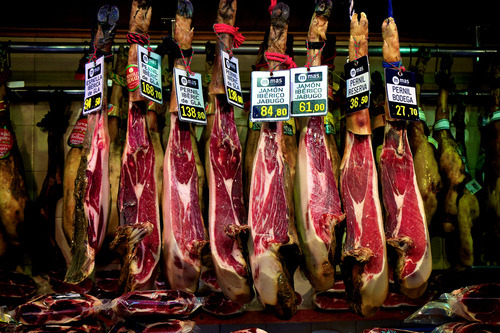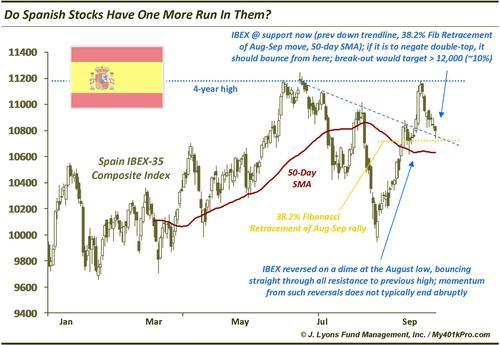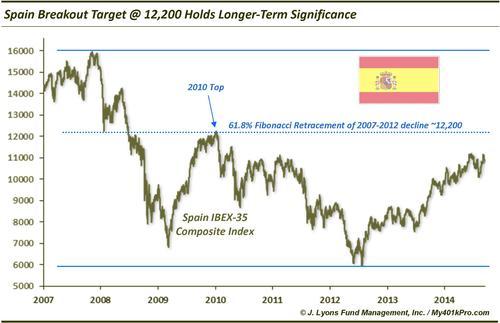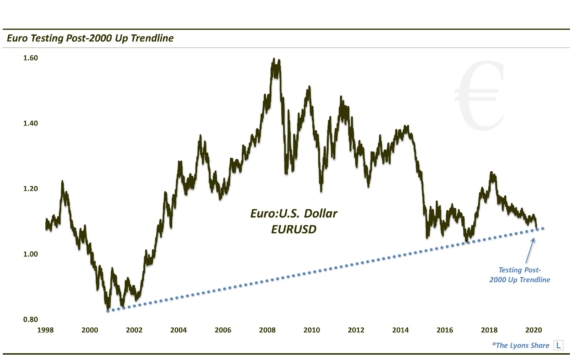Spain: This PIIG Not Yet Ready For Slaughter?

We have posted several times regarding the risky, debt-laden European countries affectionately known as the PIIGS (Portugal, Italy, Ireland, Greece and Spain) several times in this space. In addition to playing a consequential part in the economic well-being of the European Union, the pricing of the PIIGS debt and equity can give us clues regarding the level of risk in the markets.
In May, just when it looked like the PIIGS’ 2-year run may be over, Mr. Draghi and the ECB breathed new life with talk of negative rates and quantitative easing. Instantly the PIIGS rebounded. Unfortunately, the rally was short-lived and by July, we were warning of the relative breakdown in the PIIGS markets.
But alas, not all of the PIIGS are alike and their individual markets began to diverge, separating the wheat from the chaff (or meat from the hoof). While Portugal, for example, was literally crashing, Italy and Spain were more resilient. Looking at the charts at the moment, Spain, in particular, is potentially poised for at least one last run higher.

After selling off with the other PIIGS to a lower low in August, the Spanish IBEX-35 Index made an abrupt u-turn, trading straight back to its previous highs within a few weeks. Along the way, the index broke through all possible resistance, including the down trendline from the June high. Isn’t it a double-top, one might ask. Observers of the U.S. equity market have become all too familiar with these “V-bottoms” over the past 2 years. They typically do not stop abruptly (permanently) at the former high. Therefore, after an expected pullback from the high, which is occurring now, this pattern should be expected to advance to a new high.
What is the specific setup? Initial support for the IBEX-35 lies at around 10,730, representing a confluence of the top side of the post-June down trendline, the 38.2% Fibonacci Retracement of the August-September rally and the 50-day exponential moving average. The index should bounce there and indeed, it made a low of 10,737 yesterday. Given the nature of these PIIGS markets, this is an above average-risk trade. However, the levels now offer a high reward to risk ratio of about 6:1. Longs should work fairly quickly if this trade is to work. A stop can be place on a close below the 50-day simple moving average near 10,600.
(An alternate possibility would be for the index to trade down to the 10,400 level representing the 61.8% Fibonacci Retracement of the August-September rally and the 200-day moving averages. A bounce from there would also set up a potential reverse head-and-shoulders formation. Immediate strength from current levels would be preferable, however.)
If it is able to approach the former highs, the chances are fairly good that it can break through. If it does break through, the upside target from a breakout of the V-bottom formation would be around 12,200, or about 10-12% from current levels. We may be getting aheadd of ourselves now, but that area also has longer-term significance that we have been eyeing for the past year or so.

12, 200 represents both the 61.8% Fibonacci Retracement of the 2007-2012 decline as well as the high set in 2010. Therefore, IF the IBEX-35 is to A) bounce from here, B) break out above recent highs, 12,200 is a logical target from a longer-term perspective as well as a shorter-term one.
The crux: This is a higher risk trade, but the Spanish IBEX-35’s rapid bounce and rise off its August low to previous highs suggests it perhaps has one more run in it. A bounce from current support presents an attractive reward:risk ratio. Should the index break out above recent highs, it has 10-12% upside to the short and long-term relevant level of 12,200.
Then again, maybe it’s a double-top and this PIIG is ready to be turned into jamon.
__________
More from Dana Lyons, JLFMI and My401kPro.
“Jamon” photo by Mike Rowe.

